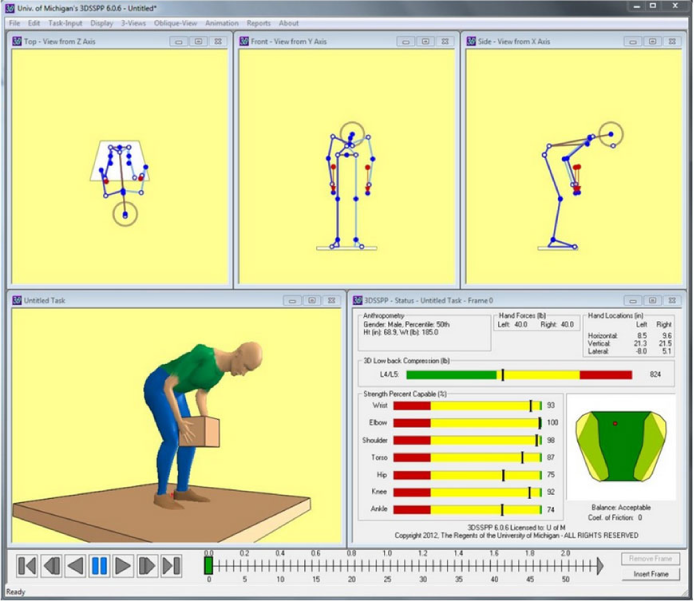Our clients have realized:
- Increased Savings
- Increased Quality Improvement
- Increased Sales
- Increased Company Morale
- Increased Productivity
- Increased Early Reporting of Discomfort
- Decreased Waste and Scrap Rates
- Decreased Workers Compensation Costs
- Decreased Musculoskeletal Injuries
- Decreased Injury Severity Rates
- Decreased Absenteeism
- Decreased Lost Work Time
- Decreased Insurance Premiums
There is no “One Size Fits All’ program for effective ergonomics. Our approach is adapted to the nature of the company, its business, employees, customers, products and work processes. Whether you are reactive and responding to problem areas or you are proactive and anticipating potential problem areas, we will tailor the interventions and programs to fit your needs.
Our ergonomic assessment projects deliver to you a clearly written, dynamic report with objective documentation supported by proven, researched models and pictorial or video documentation. Vendor information can be included to make understanding and finding the products you need, easier. Often the ergonomic changes simple administrative or behavioral controls that are inexpensive. We review the information in a working meeting (many times in the work area), with all who will be involved in the process, so the findings are clear to all involved and implementation is simplified. This process allows for feedback of feasibility by a number of different individuals with diverse backgrounds. This also serves as a planning time to meet your short and long term planning activity goals.
We adhere to the following guiding principles to provide services that are proactive, affordable and sustainable:
- Management commitment to the process and to the KYEL Group Inc. partnership standards.
- Employee involvement in all stages.
- Training included for all those involved.
- Hazard information and reporting
- Evaluation and Process Management necessary to ensure program is working correctly.
- Process Tailoring: We will work with you to ensure that the ergonomic recommendations fit seamlessly into any process initiatives you are currently utilizing or wish to use. (5S, VPP, Six Sigma: Green and Black Belt projects, and Kaizen).
INDIVIDUAL/GROUP TRAINING
Our ergonomic training programs are structured individually or in a group to give you the flexibility and comfort to choose what you want to have presented. There are a variety of levels of materials available for presentation or for training purposes. Contact us and inquire about what might be best for you.
Some training options:
- Office and Industrial Applications
- Basic, Intermediate and Advanced Levels
- Team Training
- Engineering Applications
- Musculoskeletal Link
- Job Hazard Analysis
- cost justification
Our experts will work with you to develop, implement and sustain a new or modify an existing ergonomic process. All of our training programs include reproducible handouts.
ROOT CAUSE ANALYSIS
No matter what industry you’re in, workplace near misses, accidents and injury, disrupt the workplace. Injury potential rises and the work environment changes. You may even face fines or a lawsuit.
Conducting a root cause analysis prevents similar near misses, accidents and injury, and their consequences, from happening again. When you abate the root cause of a problem, your employees feel safer at work and you’ll be protected from costly legal fees or reputation damage.
A root cause analysis is not just for workplace accidents, though. You are able to use a root cause analysis to determine if a specific activity or task is a cause for an injury. Does the available modeling and tools support that there is a hazard and that this hazard could cause this injury. In the hands of a trained medical professional this can be helpful in determining liability.
Use RCAs to resolve:
- Injuries and illnesses
- Near misses
- Quality control problems
- Processes and procedures
- Health and safety issues
- Equipment or tool failure, malfunction or correct usage
Let us help you through the process of:
- What happened
- How did it happen
- Why it happened
- What needs to be corrected
FACILITY RISK MAPPING
Facility Mapping
- Do you have an area of your plant that has injuries, but you are not able to narrow which activities are causing the problems?
- Do you have injuries, but there is no apparent pattern to where and why you are having them?
- Do you have production issues that you are unable to correct?
This method of mapping is a way to determine a hierarchy of severity and your course of action to begin ridding your facility of these problems. This is a systematic method used to begin the process of identifying problem areas.
Many different modeling programs such as NIOSH Lift Equation and University of Michigan 3D Static Strength Model in addition to REBA, RULA, Strain Index, Snook Tables, Ohio Push/Pull tools are utilized to lay out a hierarchy of risk or utilized as a trend analysis. This method is utilized in the beginning of your safety, ergonomic or injury process to provide you a “road map” to follow. From this, a course of action can then be determined based on the criteria you have established or the goals you desire to meet.


